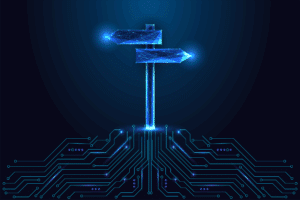Imagine a factory where the machinery itself schedules repairs before a breakdown ever occurs, or a power grid that reroutes electricity to prevent outages during a storm.
This is not science fiction; it’s the reality made possible by the strategic integration of information technology (IT) and operational technology (OT). For decades, these two realms operated in isolation. IT encompasses the systems that manage data – computers, storage, and networks. OT manages physical processes and industrial equipment, such as control systems, sensors, and actuators.

IT/OT convergence in settings like “smart factories” is no longer science fiction.
IT/OT convergence covers all the bases when it comes to workflow optimization and protecting your networks. It breaks down the long-standing barriers between an enterprise’s network and its industrial floor, creating a unified ecosystem. In this converged environment, data flows directly from the physical world of OT into IT systems for analysis. However, bridging this gap also introduces new security vulnerabilities. To gain a greater understanding of IT/OT convergence, we’ll explore its driving forces, significant benefits, inherent challenges, and real-world applications.
Why Now? The Driving Forces Behind IT/OT Convergence
While not a novel idea, the merging of IT and OT has rapidly increased recently. Several key forces are propelling this integration to the forefront of industrial strategy, making it a necessity for organizations seeking a competitive edge.
1. Industry 4.0 and Digital Transformation
At its core, IT/OT convergence is a cornerstone of the broader digital transformation sweeping across every sector. This movement, often called Industry 4.0, is characterized by the shift toward automated, data-driven industrial environments.
To build a smart factory, organizations must have a seamless flow of information between operational machinery and business analytics platforms. Convergence provides the foundational architecture for this flow, enabling the advanced automation, machine learning, and artificial intelligence applications that define Industry 4.0.
2. The Industrial Internet of Things (IIoT) Data Explosion
Modern industrial environments are now blanketed with a vast network of sensors, smart devices, and connected machines that generate an unprecedented volume of data. This IIoT explosion has created a massive influx of valuable information directly from the operational floor – data on equipment performance, environmental conditions, production output, and energy consumption.
The value of this data depends on effective collection, processing, and analysis. IT/OT convergence provides the essential bridge to transport data analytics from its source in the OT domain to powerful IT systems that turn it into actionable insights.
3. Real-Time Insights as a Competitive Edge
Historically, business decisions were often based on historical data that could be weeks or even months old. With IT/OT convergence, organizations can analyze live operational data as it is generated.
This enables dynamic adjustments to production schedules. It also allows for predictive maintenance alerts, preventing failures, and a more agile response to disruptions or shifts in demand.
4. Efficiency, Cost Savings, and Cybersecurity
By integrating IT and OT, organizations can optimize processes with a precision that was previously impossible. Predictive maintenance reduces expensive unplanned downtime, optimized energy management lowers utility costs, and streamlined workflows minimize waste.
Organizations facing global competition and economic pressures find the financial benefits of converged infrastructure a compelling investment. It’s a core strategy for sustainable growth and cybersecurity for critical infrastructure.
Key Benefits of a Converged Manufacturing Landscape
The strategic fusion of IT and OT opens up a wealth of business value, transforming traditional industrial operations into intelligent, agile, and resilient ecosystems. By creating a seamless data feedback loop between the factory floor and the front office, convergence delivers tangible benefits that ripple across the entire organization.
Enhanced Operational Efficiency
In a non-converged environment, operational data is often isolated within OT systems, making it difficult to get a holistic view of the entire production process. Convergence allows the aggregation and analysis of data from every machine, sensor, and control system in one place.
This unified view enables:
- Workflow optimization through the elimination of bottlenecks
- Precise resource allocation of raw materials, labor, and energy
- Predictive maintenance, where IT analytics use real-time OT data to monitor equipment health
Instead of reacting to unexpected breakdowns – which cause costly unplanned downtime – organizations can schedule maintenance proactively. They can also ensure machinery runs at peak performance, which will help extend its lifespan.
Data-Driven Decision-Making
While a new environment also comes with a learning curve, organizations can expect convergence to support true data-driven decision-making once teams find a routine.
Advanced IT analytics platforms can process OT data to reveal hidden trends, correlations, and insights that would otherwise go unnoticed. That means business leaders can base strategic decisions on live, granular data from the heart of their operations.
Practical examples include:
- Adjusting production parameters in real time to improve product quality
- Analyzing supply chain logistics to reduce transportation costs
- Using energy consumption data to optimize procurement strategies
Agility and Innovation
The ability to access and analyze real-time operational data allows organizations to adapt quickly to changing market conditions. If a new customer order requires a change in product specifications, an integrated system can automatically reconfigure the assembly line.
Beyond agility, companies can leverage operational data to:
- Develop new data-driven services
- Offer customers performance analytics
- Shift toward usage-based or subscription business models
Strengthened Safety and Security
No doubt integrating IT and OT introduces new security challenges. However, a well-executed convergence strategy can ultimately lead to improved safety and security.
In siloed environments, OT security is often neglected or managed with outdated practices. Convergence changes this by bringing the full force of modern IT security expertise and tools into the OT domain.
This allows for:
- Comprehensive monitoring and threat detection
- Unified incident response capabilities
- Consistent security policies across all connected assets
Navigating the Hurdles: Common Challenges in IT/OT Processes

The most significant and widely discussed challenge of IT/OT convergence is the escalation of cybersecurity risks.
To merge the two historically separate worlds of IT and OT, organizations must navigate a series of technical, cultural, and security hurdles.
Perhaps the most significant and widely discussed challenge is the escalation of cybersecurity risks.
Traditionally, engineers designed OT systems for reliability and safety within isolated, air-gapped networks. Connecting these systems to IT networks and the internet exposes critical infrastructure to a host of new attack vectors, from malware and ransomware to targeted attacks.
Securing this newly expanded attack surface requires a fundamental rethinking of industrial cybersecurity.
Challenges with Legacy Systems
The operational landscape is often a patchwork of equipment from different vendors, spanning decades of technological evolution.
Making these older, purpose-built devices talk to modern, IP-based IT infrastructure can be a technical challenge. It often requires specialized gateways, protocol converters, and custom software development. This process is complex and costly, and it carries the risk of disrupting sensitive operational processes if not managed with extreme care.
Bridging the Two Cultures
The primary focus of IT has always been on data confidentiality, integrity, and availability, with a culture of frequent updates and rapid change.
Conversely, safety, reliability, and uptime are the top priorities for OT teams. There, stability is valued and change is resisted; the guiding principle is “don’t touch it” if a system is functional.
IT professionals may not appreciate the real-world safety implications of a system reboot, while OT engineers may be wary of IT security policies that could impact operational performance. Overcoming this divide requires a new, collaborative culture built on mutual respect and shared goals.
Additionally, the convergence of IT and OT has created a significant skills gap.
The ideal professional for managing a converged environment is knowledgeable in both enterprise networking and cybersecurity, as well as industrial control systems and physical processes; they are a hybrid expert.
Many organizations find themselves lacking the in-house talent needed to implement and secure a converged architecture. This shortage of hybrid expertise can leave organizations vulnerable. Building these skills internally through cross-training or recruiting them externally is often the first challenging step of the convergence journey.
IT/OT Integration in Action: Real-World Use Cases
The theoretical benefits of IT/OT convergence come to life in its real-world applications across industries. From manufacturing to energy to logistics, IT/OT integration is reshaping the industrial landscape.
Smart Manufacturing
Consider a modern automotive plant where IT/OT convergence is at the heart of operations. Welding robots on the assembly line (OT) continuously feed sensor data into an IT-based quality control system. This system uses algorithms to detect minute deviations in weld quality that would be invisible to the human eye. The system automatically adjusts the robot’s settings or flags the part for inspection when it finds a potential defect.
In another example, an assembly line can be dynamically reconfigured based on new orders received by the enterprise resource planning system (IT). The IT system sends new product specs directly to OT controllers on the factory floor to adjust machines, enabling customized production. The seamless data exchange between IT and OT systems, strengthened by partnerships like the one between Claroty, Parsons, and SealingTech, directly results in this high level of automation and quality control.
Nuclear Power Plant Operations and Security
Inside a nuclear facility, thousands of sensors and industrial controllers (OT) monitor reactor temperatures, coolant flow, turbine speed, and radiation levels. This data is transmitted to IT-based control systems where analytics detect anomalies, predict equipment failures, and guide operators on preventive action. For example, predictive models can flag unusual pump vibrations before they compromise coolant circulation — a safeguard against both downtime and safety risks.
The convergence of IT and OT in these plants allows operators to balance energy output with real-time demand while protecting against cyber threats. Attacks like Stuxnet exposed how vulnerable programmable logic controllers and human-machine interfaces can be when networks are not properly segmented. Today, DOE-backed initiatives and NERC CIP standards push for defense-in-depth strategies, including continuous monitoring, microsegmentation, and zero trust architectures.
Leveraging solutions like SealingTech’s edge compute servers at the OT perimeter gives analysts real-time visibility without interfering with sensitive control processes, ensuring compliance and strengthening the nation’s critical infrastructure.
Logistics and Transportation
GPS sensors and engine diagnostics systems (OT) on every truck in a fleet transmit a constant stream of data about location, speed, fuel consumption, and vehicle health.
A central IT platform aggregates this data and optimizes delivery routes in real time based on live traffic conditions, weather reports, and delivery windows. The system can alert drivers to potential delays and suggest alternative routes, saving time and fuel.
Best Practices for Your Organization’s IT/OT Convergence Strategy
To successfully navigate the complexities and reap the rewards of IT/OT integration, organizations should adhere to a set of best practices designed to align technology, people, and processes.
Develop a Unified Strategy

Succeeding in IT/OT convergence means making decisions and creating a clear, comprehensive roadmap developed collaboratively.
A successful convergence initiative cannot be driven by the IT or OT departments in isolation. It must begin with a clear, comprehensive roadmap developed collaboratively. This strategy should outline the specific business goals the convergence aims to achieve, such as reducing downtime by a certain percentage or improving production quality.
It should also include a phased implementation plan that starts with pilot projects to demonstrate value and manage risk before scaling up. A critical part of this strategy involves understanding how to achieve a state of readiness, similar to the objectives laid out in the US Army’s plan for a unified network and zero trust architecture.
Foster Cross-Cultural Collaboration
The cultural divide between IT and OT is one of the biggest obstacles to convergence.
Integrated teams with members from both departments should be jointly responsible for the implementation and maintenance of converged systems. Regular joint meetings, shared training sessions, and clear communication channels are the backbone of mutual understanding.
Implement a Defense-in-Depth Security Model
A multilayered security approach is necessary to protect the entire ecosystem, from the data center to the individual sensors on the factory floor. This model should include several layers of protection:
- Network segmentation: Isolate critical OT systems from the IT network and the internet to limit the potential blast radius of an attack
- Access control: Implement strict access control policies based on the principle of least privilege
- Threat monitoring: Deploy continuous monitoring solutions that can detect anomalous behavior on both IT and OT networks
- Endpoint protection: Secure all connected devices, including industrial controllers and workstations, with appropriate security software
- Incident response plan: Develop and regularly test an incident response plan that specifically addresses security events in the OT environment
The needs of the organization will evolve, and the volume of data generated by IIoT devices will continue to grow. That means the hardware and software solutions chosen for the convergence initiative must be able to scale accordingly.
Flexible hardware solutions, such as SealingTech’s line of edge compute servers and US 10 MicroServer, are adaptable and can grow with an organization’s needs, providing a future-proof foundation for the converged infrastructure. This foresight prevents the organization from being locked into proprietary systems that will limit its agility and innovation in the long run.
Frequently Asked Questions
What is an example of IT and OT convergence?
A great example of IT and OT convergence is a predictive maintenance system in a smart factory. In this scenario, sensors (OT) like SealingTech’s AegisEdge MicroServers are placed on critical machinery to monitor factors like vibration, temperature, and energy consumption in real time. The OT sends this raw data to an IT network, where advanced analytics process it on edge computing systems such as SealingTech’s SN 5100 or SN 7100. It then stores the data on a larger storage-focused system, such as their SN 9000, for software analysis. This software analyzes the data for patterns that indicate a potential future failure. Predicting breakdowns, the system automatically creates a maintenance work order and alerts the team.
The same customer can also use SealingTech’s AegisEdge US 10 MicroServer to protect smaller devices on their corporate network. The customer already uses the same US 10 devices on their ICS/OT equipment, so a similar architecture exists within their company. Here, too, data flows freely from the sensors onto the customer’s IT network to the SN 5100/7100 for a central aggregation point. It can then move to an SN 9000 for long-term data storage and analysis. At each stage, SealingTech seeks to utilize the same devices, thus reducing complex operational costs and architecture complexity.
Both examples highlight how IT/OT architectures are very similar in practice. They also demonstrate that when a company-wide solution is implemented, the sticker shock and implementation headaches are reduced.
What is the difference between IT and OT networks?
IT networks manage data and support business applications like email, finance, and customer relationship management. Their main priorities are data confidentiality, integrity, and availability. OT networks, in contrast, control and monitor physical processes and industrial equipment. Their absolute highest priorities are operational safety, reliability, and continuous uptime. Downtime in an OT network can lead to production loss, equipment damage, or even a safety incident.
How do you converge IT and OT?
Converging IT and OT begins with a roadmap with clear business objectives, developed collaboratively by both IT and OT departments. A crucial technical step is establishing secure network connectivity between both environments. This involves integrating different communication protocols, often requiring gateways to translate between proprietary OT protocols and standard IT protocols like TCP/IP. A major component is implementing a comprehensive, defense-in-depth cybersecurity strategy that includes network segmentation, access control, and continuous monitoring for both environments.
SealingTech: Your Partner for a Secure IT/OT Environment
The convergence of information technology and operational technology represents a profound shift in the industrial and commercial landscapes. A unified ecosystem where data from the physical world informs business strategy in real time allows organizations to optimize manufacturing processes. It also provides flexible cyber protection for critical infrastructure and commercial entities. As we have seen, the path to convergence has its challenges – from navigating cybersecurity risks to bridging cultural divides. However, the rewards of data-driven intelligence and market agility are increasingly essential for competitive survival.
Successfully navigating this complex journey requires a partner with deep expertise in both the operational and security demands of these unique environments. SealingTech stands at the forefront of this field, offering the advanced solutions and strategic guidance needed to securely integrate your IT and OT landscapes. Their OT offerings expand again with their soon-to-be-released MS 100. Scalable and built for harsh environments, SealingTech’s smallest form factor will deliver robust performance along with out-of-band management capabilities.
SealingTech understands that true convergence is not just about connecting systems – it is about building a secure, resilient, and intelligent foundation for the future of your operations. Let us help you cover all your bases when it comes to optimizing workflows and protecting your networks. And turn the transformative potential of IT/OT convergence into your organization’s reality.
To learn more about how we can help you build a secure and efficient converged environment, request a quote or contact us today.
Related Articles
Future-Proofing Quality in a Rapidly Changing Industry
Innovation moves fast. In the world of cybersecurity manufacturing, tools, technologies, and threats evolve at a pace that can make yesterday’s best practice—today’s blind spot. At SealingTech, we see this…
Ransomware as a Service (RaaS): Explained
The days when cybercriminals built single-use ransomware and manually pushed it into one organization’s network are gone. Criminals still extort ransoms – and less technical actors still deploy traditional strings…
Industrial Control Systems Cybersecurity: A Guide to Best Practices
Industrial control systems (ICS) keep the modern world running. They meter electricity across power grids, regulate water quality at treatment facilities, and orchestrate precision manufacturing on factory floors. They also…
Could your news use a jolt?
Find out what’s happening across the cyber landscape every month with The Lightning Report.
Be privy to the latest trends and evolutions, along with strategies to safeguard your government agency or enterprise from cyber threats. Subscribe now.